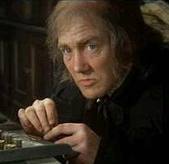I have an essay titled “Holiday Parties and the Dead” up at Connotation Press: An Online Artifact. You can check it out here.
Tag: scrooge
Bah Humbug!
Our first Christmas together, Liz and I established a now four-year-old tradition of reading aloud Charles Dickens’ A Christmas Carol, having at the time recently acquired an 1892 edition of Christmas Books and Stories Vol. I (Vol. 34 of the Works of Charles Dickens—Chapman and Hall). It’s pages being delicate, this copy remained on the shelf the following year, replaced by a ninety-nine cent Dover Thrift edition we bought at Shakespeare and Co. (the Lower Manhattan one, not the Paris “we-published-Ulysses” one). That same Christmas, Liz and I were lucky enough to gawk at Dickens’ original handwritten manuscript of A Christmas Carol, on display for the Holidays at the Morgan Library.
And this being our baby Tom’s first Christmas, we have included him in our ritual, reading him the first half of the Christmas Present chapter in one installment and the Fezziwig scene in another, his attention span being at least slightly shorter than either of our own.
For whatever reasons, A Christmas Carol is a wildly popular story, the best evidence being how widely it has been adapted. Even It’s a Wonderful Life, a Christmas tradition unto itself (and possibly A Christmas Carol’s chief rival in that regard, A Christmas Story perhaps serving as the Ross Perot of the race) seems—though based on a short story—to borrow from or at least to be influenced by its predecessor’s plot.
Liz’s favorite version is Scrooged—with Bill Murray as a Gordan Gekko-esque Ebenezer. We both fondly remember the Mickey Mouse version, its “Uncle” Scrooge trailing us through childhood as the antihero of our generation’s after school staple, DuckTales.
But my adaptation of choice would have to be the 1970 musical, Scrooge, starring Albert Finney. Though my wife enjoys her declarations that I was alive in the 70s (she may also scoff at my earlier lumping—we being an entire five years removed in age—of the two of us into the same generation), 1970 is a bit before my time—I only personally experienced 13 months of the decade—yet I somehow came into possession of a VHS copy of the musical, taped from TV. In fact, this same VHS tape also included A Charlie Brown Christmas, A Garfield Christmas, Rudolph the Red-Nosed Reindeer, Frosty the Snowman, and possibly more, all taped from TV, with the aforementioned Scrooge at the end. I remember watching the tape, dozens if not hundreds of times, always rewinding to the beginning and watching those various Christmas specials—enjoyable enough, but ultimately obstacles to the true prize, Scrooge, which I enjoyed immensely—I would watch the tape all throughout the year, not just at Christmas—attracted, for the most part—though I enjoyed the story and a couple of the songs, “I Hate People,” particularly—to the general texture of sooty yet bustling Victorian London, a period and place which—thanks to both Dickens and Sherlock Holmes, and like the Old West or Medieval England or 1920s Chicago—I often imagined myself adventuring in.
Liz and I recently rediscovered Scrooge (the musical) via YouTube. A couple of revelations:
- As a child, I believed Albert Finney (in 1970) to be elderly, though this wouldn’t account for his being a young man in the flashbacks (the magic of cinema!). I also thought that he and George C. Scott were the same person. But then I also thought that everyone on TV with a moustache was the same person.
- The YouTube version of Scrooge revealed a somewhat homoerotic scene cut from the TV broadcast I had long been viewing, in which Jacob Marley returns and drags Scrooge through hell, which is full of men with no shirts, and pulls on his chain. Alec Guinness, the original Obi-Wan Kenobi and religious figure to former and current nerds and fanboys galaxy-wide, plays a strangely effeminate Jacob Marley who is either constipated or can’t remember his lines. Or both.
